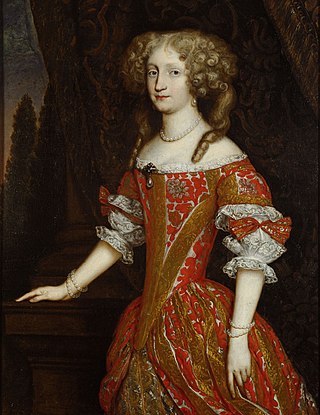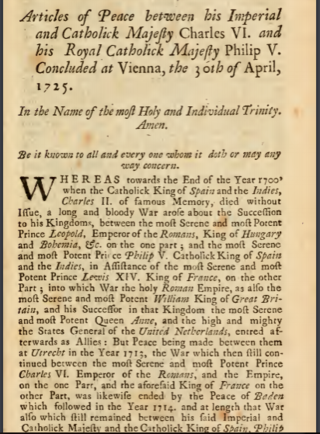
Maria Theresa was ruler of the Habsburg dominions from 1740 until her death in 1780, and the only woman to hold the position suo jure. She was the sovereign of Austria, Hungary, Croatia, Bohemia, Transylvania, Mantua, Milan, Galicia and Lodomeria, the Austrian Netherlands, and Parma. By marriage, she was Duchess of Lorraine, Grand Duchess of Tuscany, and Holy Roman Empress.

The Battle of Dettingen took place on 27 June 1743 during the War of the Austrian Succession at Dettingen in the Electorate of Mainz, Holy Roman Empire. It was fought between a Pragmatic Army, composed of the British, Hanoverian and Austrian troops, and a French army commanded by the duc de Noailles.

Joseph I was Holy Roman Emperor and ruler of the Austrian Habsburg monarchy from 1705 until his death in 1711. He was the eldest son of Leopold I, Holy Roman Emperor from his third wife, Eleonor Magdalene of Neuburg. Joseph was crowned King of Hungary at the age of nine in 1687 and was elected King of the Romans at the age of eleven in 1690. He succeeded to the thrones of Bohemia and the Holy Roman Empire when his father died.

Charles VI was Holy Roman Emperor and ruler of the Austrian Habsburg monarchy from 1711 until his death, succeeding his elder brother, Joseph I. He unsuccessfully claimed the throne of Spain following the death of his relative, Charles II. In 1708, he married Elisabeth Christine of Brunswick-Wolfenbüttel, by whom he had his four children: Leopold Johann, Maria Theresa, Maria Anna, and Maria Amalia.

Augustus III was King of Poland and Grand Duke of Lithuania from 1733 until 1763, as well as Elector of Saxony in the Holy Roman Empire where he was known as Frederick Augustus II.
A pragmatic sanction is a sovereign's solemn decree on a matter of primary importance and has the force of fundamental law. In the late history of the Holy Roman Empire, it referred more specifically to an edict issued by the Emperor.

The Habsburg monarchy, also known as Habsburg Empire, or Habsburg Realm, was the collection of empires, kingdoms, duchies, counties and other polities that were ruled by the House of Habsburg. From the 18th century it is also referred to as the Austrian monarchy or the Danubian monarchy.

Maria Josepha of Austria was the Queen of Poland, Grand Duchess of Lithuania and Electress of Saxony by marriage to Augustus III. From 1711 to 1717, she was heir presumptive to the Habsburg monarchy.

Archduchess Maria Anna Eleonore Wilhelmine Josepha of Austria was a member of the House of Habsburg who governed the Austrian Netherlands in the name of her elder sister, Empress Maria Theresa.

Eleonore Magdalene Therese of Neuburg was Holy Roman Empress, German Queen, Archduchess of Austria, Queen of Hungary and Bohemia as the third and final wife of Leopold I, Holy Roman Emperor. Before her marriage and during her widowhood, she led an ascetic and monastic life, translating the Bible from Latin to German and defended the Order of the Discalced Carmelites. Reputed to be one of the most educated and virtuous women of her time, Eleonore took part in the political affairs during the reign of her husband and sons, especially regarding court revenue and foreign relationships. She served as regent for a few months in 1711, period in which she signed the Treaty of Szatmár, which recognized the rights of her descendants to the Hungarian throne.

The Peace of Vienna, also known as the First Treaty of Vienna, was a series of four treaties signed between 30 April 1725 and 5 November 1725 involving the Habsburg Monarchy, the Holy Roman Empire, and Bourbon Spain. Later, in 1726, the Russian Empire joined this newly formed alliance. The signing of this treaty established the Austro-Spanish Alliance, which led to the Fourth Anglo-Spanish War (1727-1729). This alliance caused Austria to withdraw from the Quadruple Alliance. In this new partnership, the Habsburgs gave up all formal claims to the Spanish throne, while Spain renounced its claims to the southern Netherlands and several other territories.

The 1731 Treaty of Vienna was signed on 16 March 1731 between Great Britain and Emperor Charles VI on behalf of the Habsburg monarchy, with the Dutch Republic included as a party.

Maria Amalia of Austria was Holy Roman empress, queen of Bohemia, and electress of Bavaria among many other titles as the spouse of Emperor Charles VII. By birth, she was an archduchess of Austria as the daughter of Emperor Joseph I. One of her children was Maximilian III Joseph, Elector of Bavaria.

Wilhelmine Amalie of Brunswick-Lüneburg was Holy Roman Empress, Queen of the Germans, Queen of Hungary, Queen of Bohemia, Archduchess consort of Austria etc. as the spouse of Joseph I, Holy Roman Emperor.
The Mutual Pact of Succession was a succession device secretly signed by archdukes Joseph and Charles of Austria, the future emperors of the Holy Roman Empire, in 1703.

The Article 7 of the Sabor of 1712, better known as the Pragmatic Sanction of 1712 or the Croatian Pragmatic Sanction, was a decision of the Croatian Parliament (Sabor) to accept that a Habsburg princess could become hereditary Queen of Croatia. It was passed against the will of the Diet of Hungary, despite the Kingdom of Croatia's centuries-long association with the Kingdom of Hungary. The resulting strife with the Hungarian officials ended with the legal recognition of the Croatian Parliament's sole jurisdiction over internal Croatian affairs. The Pragmatic Sanction is thus considered one of the most historically important decisions of the Croatian Parliament, and is recalled in the preamble of the Constitution of Croatia.
The Pragmatic Sanction of 1723 was a bilateral treaty between the Diet of Hungary and the Hungarian king Charles III by which the Diet recognized the king's daughters as possible heirs to the throne in return for considerable privileges. It was a protracted affair but had lasting consequences, especially in relation to the Austro-Hungarian Compromise of 1867.

The imperial election of 1742 was an imperial election held to select the emperor of the Holy Roman Empire. It took place in Frankfurt on January 24. The result was the election of Charles Albert of Bavaria, the first non-Habsburg emperor in three hundred years.
The imperial election of 1745 was an imperial election held to select the emperor of the Holy Roman Empire. It took place in Frankfurt on September 13.

The Treaty of Nymphenburg was a treaty between Bavaria and Spain that was concluded on May 28, 1741 at the Nymphenburg Palace in Munich. It was the first formal pact of a series of French-sponsored alliances against the Habsburg Monarch, Maria Theresa. Through the agreement, the Bavarian Elector Charles Albert gained the support of King Philip V of Spain to become the next Holy Roman Emperor against the claims of the Habsburgs. The treaty was brokered by Marshal Belleisle under the authority of Louis XV of France. As part of the negotiations, the French agreed to materially support Charles Albert's claims. The treaty signaled the expansion of the First Silesian War, which started as a local war between Prussia and the Habsburg Monarchy, into the War of the Austrian Succession, a pan-European conflict.

















